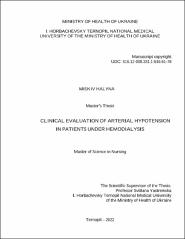Показати скорочений опис матеріалу
CLINICAL EVALUATION OF ARTERIAL HYPOTENSION IN PATIENTS UNDER HEMODIALYSIS
| dc.contributor.author | MISKIV, HALYNA | |
| dc.date.accessioned | 2022-09-02T13:42:45Z | |
| dc.date.available | 2022-09-02T13:42:45Z | |
| dc.date.issued | 2022 | |
| dc.identifier.citation | MISKIV, Н. (2022) CLINICAL EVALUATION OF ARTERIAL HYPOTENSION IN PATIENTS UNDER HEMODIALYSIS. I. HORBACHEVSKY TERNOPIL NATIONAL MEDICAL UNIVERSITY OF THE MINISTRY OF HEALTH OF UKRAINE, Ternopil. 35 р. | uk |
| dc.identifier.uri | https://repository.tdmu.edu.ua//handle/123456789/17535 | |
| dc.description.abstract | This study evaluated various aspects of arterial hypotension during hemodialysis. Scientific literature data indicate that IDH is a common complication of hemodialysis and has an adverse effect on patient survival rates. The connection of this problem with a large number of factors, including not only clinical aspects, but also the technical features of the hemodialysis procedure, requires an integrated approach to the study of IDH. The multifactorial nature of IDH and its connection with continuously changing medical technologies make it especially relevant to study the problem in the context of modern domestic healthcare practice. These issues were considered by us in the context of determining the rational scope of measures aimed at preventing this complication. To solve the research objectives, 102 patients with stage 5 CKD were selected, who did not have significant primary diseases of the cardiovascular system and endocrine pathology, which can also be the causes of arterial hypotension. Dividing the observed patients into groups depending on the frequency of IDH episodes, we compared them according to clinical and laboratory data. Both patient-specific factors and factors related to the hemodialysis procedure were considered. The frequency of episodes of intradialysis hypotension was correlated with the duration of treatment with program hemodialysis and the nature of the underlying disease. In patients with diabetic nephropathy, intradialysis hypotension was observed 2.6 times more often than in patients with chronic glomerulonephritis, and 5.3 times more often than in patients with polycystic kidney disease (p<0.01). The average monthly number of episodes of intradialytic hypotension has a negative correlation with body mass index (rs= -0.234; p=0.039). Among patients with frequent episodes of intradialytic hypotension, underweight was more common than among patients in whom episodes of intradialytic hypotension were not observed. The average monthly number of episodes of intradialysis hypotension negatively correlated with the average level of both predialysis systolic (rs= -0.399; p<0.001) and postdialysis systolic BP (rs= -0.691; p<0.001). Intradialysis systolic blood pressure correlated positively with serum albumin (rs=0.515; p=0.041) and negatively with the duration of hemodialysis treatment (rs= -0.458; p=0.042). The presence of episodes of intradialytic hypotension was associated with reduced levels of hemoglobin and hematocrit. The ratio of interdialysis weight gain and ultrafiltration volume to dry weight positively correlated with the duration of hemodialysis treatment and the average monthly number of episodes of intradialysis hypotension. | uk |
| dc.language.iso | en | uk |
| dc.publisher | Ternopil | uk |
| dc.subject | ARTERIAL HYPOTENSION | uk |
| dc.subject | HEMODIALYSIS | uk |
| dc.subject | blood pressure | uk |
| dc.subject | intradialysis hypotension | uk |
| dc.subject | body mass index | uk |
| dc.subject | chronic kidney disease | uk |
| dc.subject | ischemic heart disease | uk |
| dc.subject | parathyroid hormone | uk |
| dc.title | CLINICAL EVALUATION OF ARTERIAL HYPOTENSION IN PATIENTS UNDER HEMODIALYSIS | uk |
| dc.title.alternative | Master's Thesis | uk |
| dc.type | Thesis | uk |

